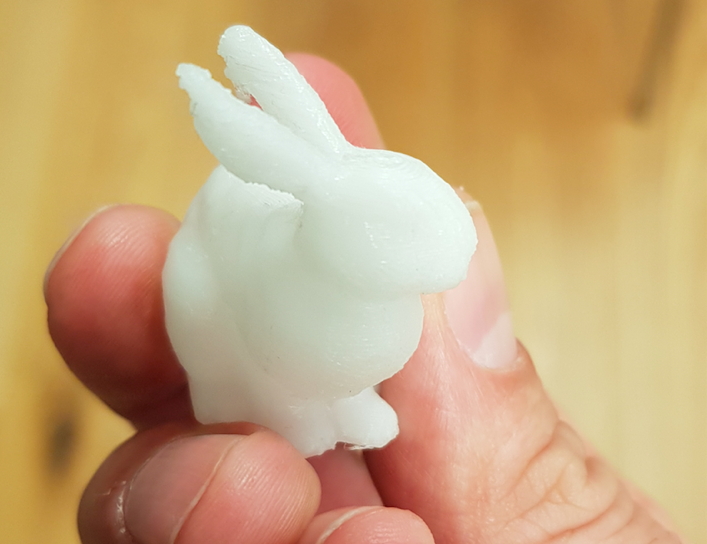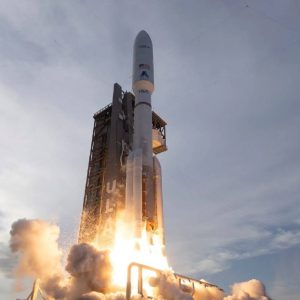
Researchers from ETH Zurich has discovered a new method for turning nearly any object into a data storage unit – successfully storing megabytes of data in a 3D printed plastic rabbit and the lens of a researcher’s glasses, using a technique that they are dubbing the DNA of Things (DoT).
The technique relies on embedding a DNA “barcode” in silica nanobeads, which are fused into a material of choice.
“DoT could be applied to store electronic health records in medical implants, to hide data in everyday objects and to manufacture objects containing their own blueprint. It may also facilitate the development of self-replicating machines”, the team said in a paper in Nature Biotechnology, published Monday.
The research was led by ETH Zurich’s Robert Grass, professor at the Department of Chemistry and Applied Biosciences and Yaniv Erlich, a former professor of Computer Science at Columbia University and CSO of genealogy platform MyHeritage (working on this project in an independent capacity).
“With this method, we can integrate 3D-printing instructions into an object, so that after decades or even centuries, it will be possible to obtain those instructions directly from the object itself,” explained Grass .
In the paper, the research team detailed how they stored a 1.4 MB video in DNA in plexiglass spectacle lenses and retrieved it by excising a tiny piece of the plexiglass and sequencing the embedded DNA. They also 3D printed a rabbit out of plastic, which contains the instructions for printing itself.
 Erlich had another left-field idea: “[You could hide information James Bond style. Since silica beads are biocompatible you can theoretically drink them and urinate the files in the other side of the boarder (don’t try at home!)”.
Erlich had another left-field idea: “[You could hide information James Bond style. Since silica beads are biocompatible you can theoretically drink them and urinate the files in the other side of the boarder (don’t try at home!)”.
He added: “The DNA of Things is an application where current DNA synthesis is not overly cost prohibitive…”
Translating a 3D-printing file like the one stored in the plastic rabbit’s DNA costs around 2,000 Swiss francs (£1,500), Grass said; most of the cost being to synthese the DNA molecules; the larger the batch size, the lower the unit cost.
We used our "DNA of things" architecture to store the 3D printing file (stl file) of the bunny in DNA. Then, we took the DNA, encapsulated it in silica beads, mixed the beads with PCL plastic, extruded, and printed the bunny.
The end result? pic.twitter.com/yCBJIzgdGq
— Yaniv (((Erlich))) (@erlichya) December 9, 2019
“All other known forms of storage have a fixed geometry: a hard drive has to look like a hard drive, a CD like a CD. You can’t change the form without losing information,” Erlich added in a ETH Zurich blog post. “DNA is currently the only data storage medium that can also exist as a liquid, which allows us to insert it into objects of any shape.”
The technology could be used to mark medications or construction materials such as adhesives or paints, the two said, allowing workers doing renovations to find out which products exactly were used in the original structure.
DNA of Things: How it Works
The project draws on earlier work by Erlich and other researchers based around a process dubbed “DNA Fountain” (code available on GitHub here).
In a December 2016 paper, he detailed storing a full computer operating system, movie, and other files in DNA oligos and “perfectly” retrieving the information “from a sequencing coverage equivalent of a single tile of Illumina sequencing.”
As DNA is a robust biomolecule, which can last for thousands of years, it has significant potential as a storage medium. In DNA Fountain, rather than converting an entire digital file into a long sequence of DNA, the researchers used fountain codes to generate small digital packets called droplets that could then be converted into DNA segments, as a piece in Evolving Science details.
“The process begins by breaking the data up into short segments of four bits. The data is further processed by series of mathematic expressions called a Luby transformation to give the droplet of six-bits. Each set of bits (00, 01, 10 and 11) corresponds to a nucleotide base (Adenine, Cytosine, Guanine, and Thymine). So, a six-bit sequence of 001011 would create the oligonucleotide AGT.
“From here, the sequences are checked to make sure they are valid; repeat sequences (TTT) and high GC sequences (GGG, CCC, GCG, CGC) are disregarded and the sequence returned to the Luby transformation until a valid sequence is generated. Once the droplets have been screened and approved the oligonucleotide sequences were synthesized. For this [2016] experiment, the team made an archive file that contained an Amazon gift card, an operating system, an image, a pdf file, a computer virus and a French film from 1895; a total of 2.1 MB. The end result was 72,000 oligonucleotide strands of DNA, each 200 base pairs long.”
The DNA of Things research is the latest to take an unusual approach to data storage.
Microsoft’s Cambridge-based research centre and the University of Southhampton’s Optoelectronics Research Centre are working on a project that uses lasers to encode data in glass; last month successfully storing the 1979 film Superman on a piece of glass 75mm by 75mm by 2mm thick.
That technique uses a laser to encode data in glass by creating layers of three-dimensional nanoscale gratings and deformations at various depths and angles. Machine learning algorithms then read the data back by decoding images and patterns that are created as polarized light shines through the glass.
As with the DoT approach, the aim is to create a data storage method that is longer lasting than more volatile and degradable contemporary techniques.






